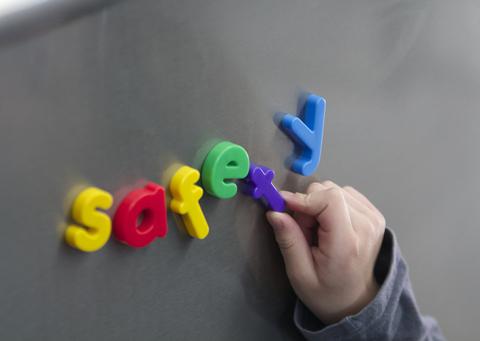
Standards and Consumer Safety
Q. How did you get involved in standards work and why is it important?
A. After college, I was very quickly exposed to the existence of standards and their importance. I was a loss control engineer for an insurance company, and as part of my role I would evaluate a company’s level of risk for product-liability insurance. One of the most important parts of that evaluation was to determine if the company designed and tested their product to a minimum safety standard. Without proof or confirmation, the process would not move forward.
I began working with Bureau Veritas (BV) in 2000 and almost immediately joined ASTM International and began to participate in the standards-development process.
The BV Consumer Products Services Division, where I work, tests consumer products for safety and quality for manufacturers and retailers across the globe. We work with the largest retailers and manufacturers in the world, medium and small boutique companies, and online retailers. Most of the manufacturing is done outside the United States, and the U.S. is one of the biggest importers of consumer products. Wherever manufacturers are, they want to be sure that the product is safe and meets all regulations and quality requirements. To help ensure that, standards like those developed by ASTM give our customers a minimum safety standard as a starting point for their products, and they give BV internationally recognized standards for all of our labs to test against. This allows for consistency across our organization.
READ MORE: Keeping Consumer Products Safe
It is extremely important for me and my team to participate in the standards-development process as well. Keeping up with ever-changing requirements and understanding the rationale is important so that we can consult with our customers and help them understand when their products need to be changed. It is also important for communicating to our lab network so they can train on the new requirements, develop capabilities, purchase any needed new equipment, and apply for our updated accreditation. This process is quite time consuming, so staying ahead of new developments helps us complete this in a timely manner. Participation in the standards-development process is also a great educational opportunity that allows safety professionals to learn, grow, and network with other professionals.
Q. How do ICPHSO — International Consumer Product Health and Safety Organization — and the consumer products committee (F15) complement each other and work together?
A. ICPHSO and the ASTM product committees are a perfect complement for each other. Most of the people that I interact with during committee meetings are not just interested in safety because it is part of their job, but because they are passionate about product safety. ICPHSO gives all product-safety stakeholders a forum to be able to get together. We discuss current industry changes, challenges that people have regarding product development and safety, and new regulatory requirements. Attending an ICPHSO conference also affords a great opportunity to network with other industry leaders, regulators, and professionals and educate yourself about the industry.
Many ICPHSO members participate in ASTM committees and are also passionate about product safety. Many current topics and committee activities are also discussed during ICPHSO conferences: furniture tipover, magnets, internet of things, artificial intelligence, liquid laundry packets, Inclined sleepers, and others. People want to hear from the experts who are working on developing the standards and requirements for the products they make or sell.
Q. What is the importance of testing — and testing standards — as well as certification to consumer product safety?
A. The testing of consumer products is of utmost importance for a variety of reasons and can take on different forms. Product testing happens at various times during production, from raw material testing to production testing to final production testing. This testing is typically first party (by the manufacturers themselves) or third party (independent test labs).
Production testing happens because manufacturers don’t want to wait until the finished product comes off the line and then find out that something happened during production that significantly impacts either the quality or safety of a product. Testing will also be done ahead of shipping as a last check for the retailer or the importer to make sure that everything has been done correctly during production.
All stages of testing are important to ensure the supply chain is working the way it should. Testing also confirms that there were no material changes during production that could change product safety or quality. For the majority of our testing, we look to established industry standards. Testing standards play an integral role in providing guidance for a minimum level of safety for products as well as requirements and methods that are developed by industry experts.
In instances where there is not an ASTM standard for a certain product category, we will often look to existing standards or methods and requirements in existing standards to develop testing protocols. An example of this might be using the battery compartment markings requirement for battery-operated toys in the ASTM F963 [consumer safety specification for toy safety] standard for products that are not toys. Another example of a request that we often get is for us to perform the stability test for clothing storage units in ASTM F2057 [safety specification for clothing storage units] on other products like bookcases, cabinets, or dining room hutches and buffets.
Certification programs can play a very important role in product safety as well, providing an extra level of assurance that safe products are being produced. BV works with manufacturers to certify their products so they can use the BV mark on their products, and we also administer certification programs.
These programs will often have additional requirements in addition to testing such as design reviews, raw material testing, product inspections, and ongoing factory audits. The programs are typically administered by independent third-party providers.
FOR YOU: Safer Connected Consumer Products
Certification programs play an important part in the market, especially for higher risk products like electrical products and the juvenile products that fall under the scope of the JPMA [Juvenile Products Manufacturers Association] certification program. These certification marks give consumers a visible sign that the products have gone through a rigorous process to ensure safety.
Q. Who develops ASTM consumer safety standards? What is the importance of having consumer input to standards work?
A. Consumer product safety standards are developed by a variety of stakeholders, and all of them play an important role. These stakeholders include product developers and designers, manufacturers, engineers, retailers, third party testing labs, consultants, lawyers, regulators, and consumers and consumer advocates. The variety of stakeholders provides for different levels and types of experience and knowledge and also provides the checks and balances needed during the development process.
Consumers and consumer advocates are an invaluable part of the development process. They provide a different perspective, give real-life experience, and provide balance to the committees. A few examples where the consumer voice has made or is currently making a significant impact in the content of a standard include expansion and expandable gates, clothing storage units, liquid laundry packets, and adult magnet sets. Consumer participation and input also provide significant input and influence into the safety warnings and labels that are developed for consumer products.
Q. How does participating in and leading a large committee like F15 develop skills?
A. Participating in and leading committees is a very satisfying and rewarding experience. Committee leaders definitely develop and hone their leadership skills, which also transfer over to professional development.
When working with a variety of people and personalities, interpersonal and communication skills are key. Listening to all stakeholders to understand their position, as well as reasoning and being able to negotiate with others to potentially come up with a compromise to keep the process moving forward — these are all important in leading committees.
F15 is such a big committee and there’s so much diverse activity that it’s not feasible for any one person or even any one organization to be up to speed on everything that’s going on. The ASTM staff and our staff manager Molly Lynyak really do a great job of highlighting areas of concern, whether that’s the doings of a subcommittee, new challenges, or requests for new standards. The executive subcommittee will then discuss and determine whether we move forward with an activity or take other action.

 SN Home
SN Home Archive
Archive Advertisers
Advertisers Masthead
Masthead RateCard
RateCard Subscribe
Subscribe Email Editor
Email Editor